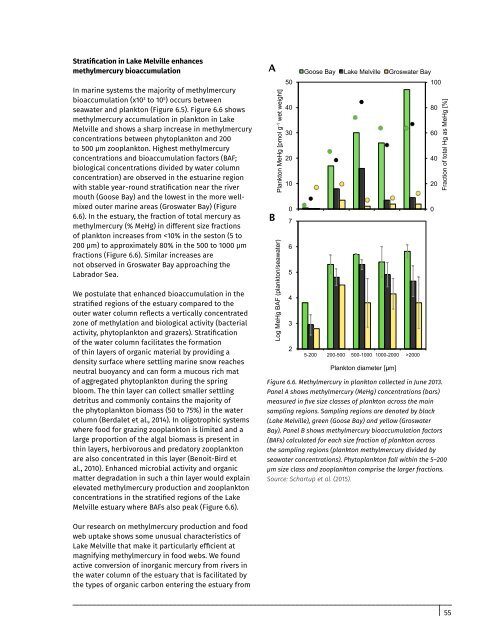Lake Melville
1rw7Mns
1rw7Mns
You also want an ePaper? Increase the reach of your titles
YUMPU automatically turns print PDFs into web optimized ePapers that Google loves.
Stratification in <strong>Lake</strong> <strong>Melville</strong> enhances<br />
methylmercury bioaccumulation<br />
In marine systems the majority of methylmercury<br />
bioaccumulation (x10 3 to 10 5 ) occurs between<br />
seawater and plankton (Figure 6.5). Figure 6.6 shows<br />
methylmercury accumulation in plankton in <strong>Lake</strong><br />
<strong>Melville</strong> and shows a sharp increase in methylmercury<br />
concentrations between phytoplankton and 200<br />
to 500 μm zooplankton. Highest methylmercury<br />
concentrations and bioaccumulation factors (BAF;<br />
biological concentrations divided by water column<br />
concentration) are observed in the estuarine region<br />
with stable year-round stratification near the river<br />
mouth (Goose Bay) and the lowest in the more wellmixed<br />
outer marine areas (Groswater Bay) (Figure<br />
6.6). In the estuary, the fraction of total mercury as<br />
methylmercury (% MeHg) in different size fractions<br />
of plankton increases from 2000<br />
5-200 200-500 500-1000 1000-2000 >2000<br />
Plankton diameter [µm]<br />
80<br />
60<br />
40<br />
20<br />
0<br />
Figure 6.6. Methylmercury in plankton collected in June 2013.<br />
Panel A shows methylmercury (MeHg) concentrations (bars)<br />
measured in five size classes of plankton across the main<br />
sampling regions. Sampling regions are denoted by black<br />
(<strong>Lake</strong> <strong>Melville</strong>), green (Goose Bay) and yellow (Groswater<br />
Bay). Panel B shows methylmercury bioaccumulation factors<br />
(BAFs) calculated for each size fraction of plankton across<br />
the sampling regions (plankton methylmercury divided by<br />
seawater concentrations). Phytoplankton fall within the 5–200<br />
μm size class and zooplankton comprise the larger fractions.<br />
Source: Schartup et al. (2015).<br />
Fraction of total Hg as MeHg [%]<br />
Our research on methylmercury production and food<br />
web uptake shows some unusual characteristics of<br />
<strong>Lake</strong> <strong>Melville</strong> that make it particularly efficient at<br />
magnifying methylmercury in food webs. We found<br />
active conversion of inorganic mercury from rivers in<br />
the water column of the estuary that is facilitated by<br />
the types of organic carbon entering the estuary from<br />
55


